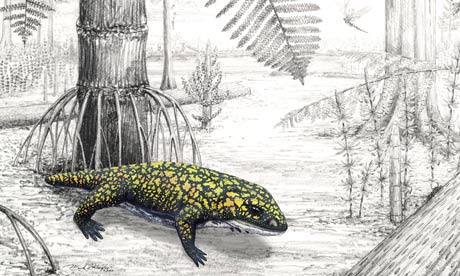It is believed that the amphibian lived in the Late Pennsylvanian Period. From my understanding of this research, the importance lies in the fact that animals with such advanced capabilities to survive as terrestrials during this time period means that the shift from water to land had begun much earlier than previously thought.
 Here's a rundown of the characteristics of Fedexia striegeli that led researchers to believe it lived a primarily terrestrial life:
Here's a rundown of the characteristics of Fedexia striegeli that led researchers to believe it lived a primarily terrestrial life:1.) Nasal opening divided into two portions: Scientists believe that the back portion held a gland that might have increased the sense of smell. This is an indication of terrestrial life because terrestrial animals rely on their sense of smell for several important life functions including locating prey, sensing predators, knowing their locations, and for sexual purposes.
2.) Lacking lateral line: This feature served as a method for aquatic animals to sense vibrations in the water - which proved helpful when attempting to locate food. However, the absence of a lateral line in Fedexia striegeli indicated that it has evolved so much from its original aquatic ancestor, that the lateral line is no longer present.
3.) Highly ossified bones: Ossification of bones indicates that they were thick and well developed, another sign that the animal was walking around supporting its body weight.
Research and discoveries in this field are extremely important and vital in the sense that -- the more we know about the animals that lived and survived in these ancient periods, the more we will know and understand what life was like at that time as well as understanding the evolutionary track they were on.

Great post Savannah, it's interesting how the time period of the transition from land to water keeps shifting earlier and earlier. How cool would it be to have an animal (extinct or not) named after you?
ReplyDeleteNice post. As much as we love Neil Shubin, this is another recent discovery that may push back the timeline for tetrapod evolution. This may mean that Tiktaalik was just one of multiple possible tetrapod ancestors. Did you see this video from Nature?
ReplyDeletehttp://www.youtube.com/watch?v=YgGwBm4HI8Q